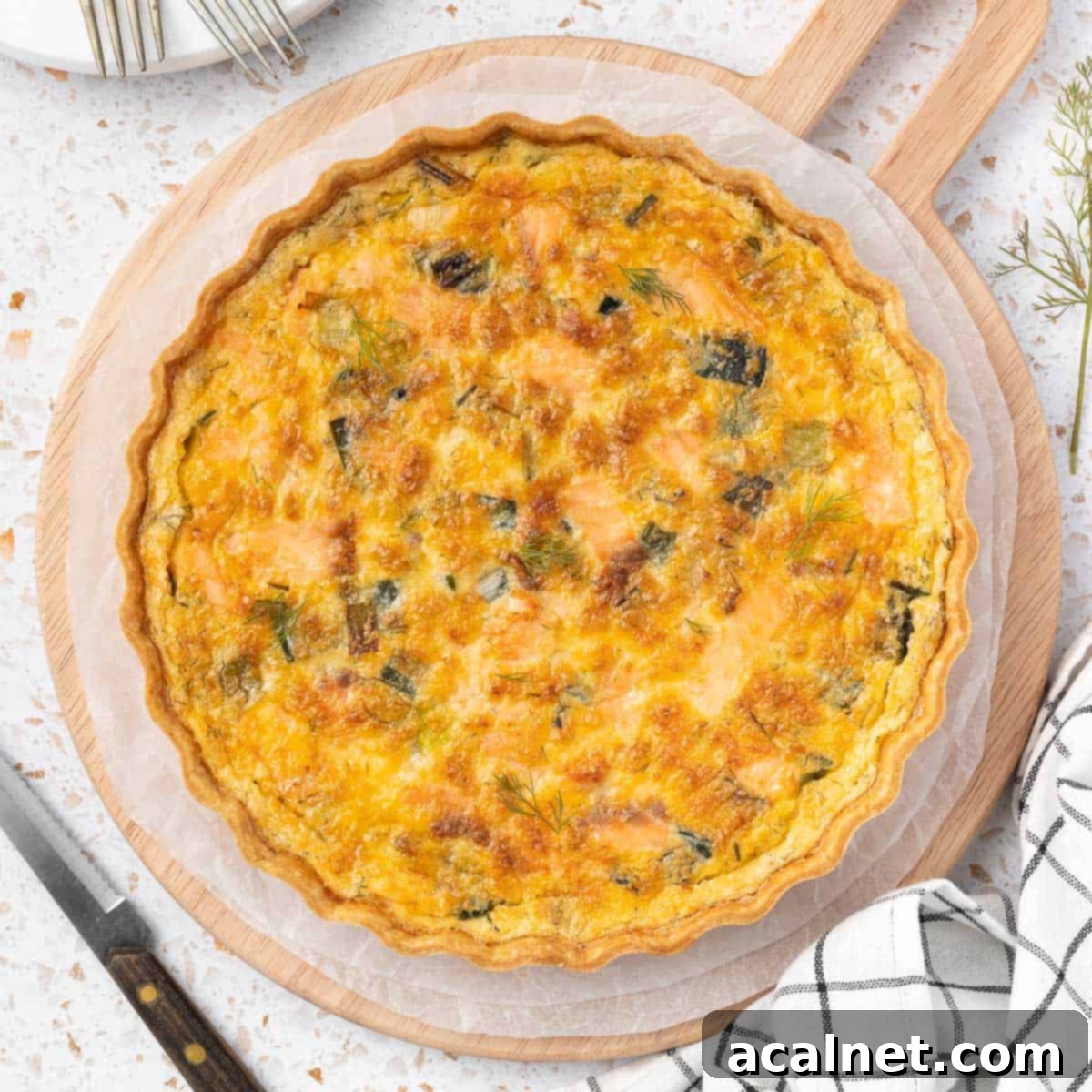Smoked Salmon Quiche with Leeks & Gruyère: Your Go-To Recipe for Brunch & Beyond
This exquisite Smoked Salmon Quiche, featuring tender leeks, rich Gruyère cheese, and a perfect homemade quiche pastry, is a truly delightful and flavorful dish. Its versatility makes it ideal for almost any occasion – serve it as an elegant appetizer for your next party, a hearty brunch centerpiece, a satisfying lunch, or a light yet fulfilling dinner.

This recipe was first posted in July 2019 and was comprehensively updated in October 2022 to provide more detailed instructions and tips for perfect results.
Why This Smoked Salmon & Leek Quiche is a Must-Try
There’s something inherently comforting and sophisticated about a perfectly baked quiche, and this Smoked Salmon Quiche with Leeks and Gruyère truly stands out. It’s more than just a meal; it’s an experience, whether you’re serving it for a festive brunch, a casual lunch, or an elegant dinner. The combination of rich, savory flavors and delicate textures makes it an instant crowd-plepleaser.
Imagine a light, flaky homemade quiche pastry providing the perfect crisp base, holding a luxuriously fluffy egg custard. This custard isn’t just any custard; it’s generously packed with tender, subtly sweet sautéed leeks, delicate slices of salty smoked salmon, aromatic fresh dill, and the nutty, tangy notes of finely grated Gruyère cheese. Each bite offers a harmonious blend of flavors and textures that is simply irresistible. This dish is not only delicious but also wonderfully versatile – serve it warm or at room temperature, making it ideal for entertaining or meal prepping.
Essential Ingredients for Your Smoked Salmon Quiche
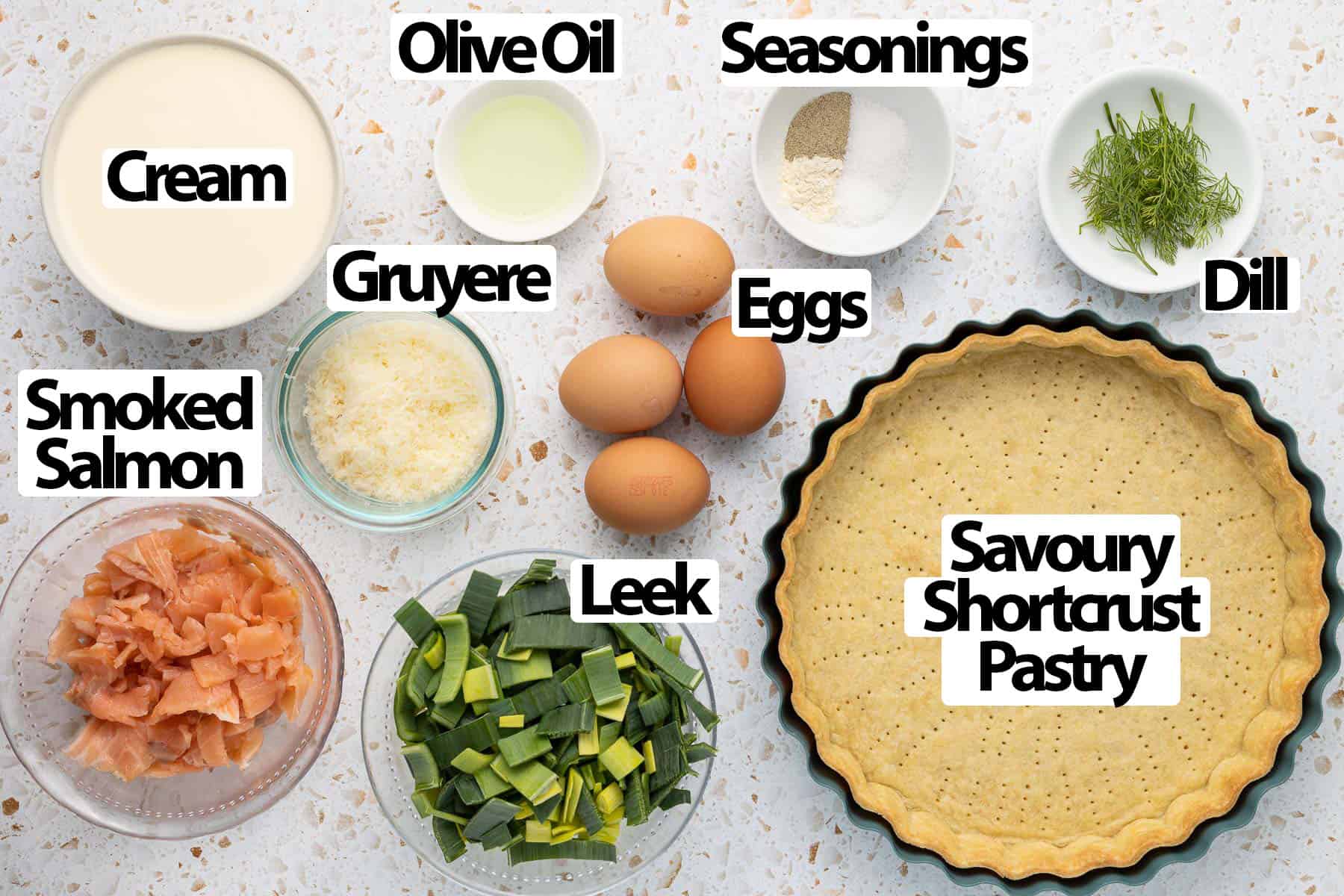
Find all exact quantities and measurements in the comprehensive recipe card below.
For the Flaky Savoury Shortcrust Pastry:
- All-Purpose Flour & Fine Salt: The foundation of our crust. Plain flour works best to create a tender, crisp texture. A touch of fine table salt enhances the overall savory profile. Feel free to experiment by adding other seasonings or spices to the dry ingredients, such as a pinch of cumin for an earthy warmth, or a hint of cayenne for a subtle kick.
- Unsalted Butter: This is critical for a truly flaky pastry. Ensure your butter is very cold and cut into small cubes. Cold butter prevents gluten development, leading to a tender crust, and creates steam pockets during baking, which results in those desirable flaky layers. Using unsalted butter allows you to control the total salt content of your quiche.
- Ice Cold Water: Just like the butter, the water must be extremely cold. This helps to keep the butter from melting prematurely and prevents the dough from becoming tough. The exact quantity can vary slightly depending on your flour’s absorption rate and environmental humidity, so always add it gradually until the dough just comes together.
For the Rich & Creamy Quiche Filling:
- Custard Base (Heavy Cream & Eggs): The heart of any quiche! A classic blend of full-fat thickened or heavy cream and large eggs creates an incredibly rich, smooth, and airy custard. Using large eggs provides the ideal structure and richness.
- Seasoning: A foundational mix of salt, freshly ground black pepper, and garlic powder. These enhance the natural flavors of the salmon and leeks. Don’t be shy to customize! A pinch of cayenne pepper can add a subtle warmth, onion powder can deepen the savory notes, or a touch of nutmeg is a classic quiche addition.
- Fresh Herbs (Dill): Fresh dill is a superstar here, perfectly complementing the smoky, delicate flavor of salmon. Its bright, anise-like notes elevate the entire dish. While optional, it’s highly recommended. If dill isn’t available, chives or parsley could also be used, though dill is truly the ideal partner for salmon.
- Cheese (Gruyère): Finely grated Gruyère cheese adds a wonderful nutty, savory depth and melts beautifully. It’s a fantastic choice, but don’t limit yourself! Parmesan cheese is another excellent option I’ve used successfully. Other hard cheeses like Swiss, Emmental, or even a sharp cheddar can also be delicious substitutes, allowing you to tailor the flavor to your preference.
- Leeks: These provide a delicate, sweet onion flavor that pairs wonderfully with salmon. When cooked until tender, they soften and mingle seamlessly with the other ingredients.
- Smoked Salmon: The star of our quiche! High-quality smoked salmon, cut into small pieces, brings a luxurious texture and distinct savory flavor that defines this dish.
- Olive Oil: Used for sautéing the leeks until they are perfectly tender and translucent, forming the base of our savory filling.
Exciting Flavor Variations to Try
While this classic Smoked Salmon Quiche is perfect as is, feel free to get creative with these delightful variations:
- Leek Substitutions: If leeks aren’t on hand, a large brown onion or even a red onion (for a slightly different, sweeter flavor) can be used. For an extra layer of freshness and a mild onion bite, consider adding some chopped spring onions (green onions) to the filling. You can also boost the vegetable content by incorporating sautéed mushrooms or wilted spinach. Just be sure to squeeze out excess moisture from spinach before adding.
- Smoked Salmon Alternatives: This recipe adapts beautifully to other smoked fish. Smoked trout, for instance, makes a fantastic substitute for smoked salmon, offering a similar smoky richness with its own unique flavor profile. For a non-smoked option, cooked, flaked fresh salmon can also be used.
- Cheese Explorations: The world of cheese offers endless possibilities! Many cheeses pair wonderfully with smoked salmon. Try adding small dollops of cream cheese or crumbled goat cheese over the top of the quiche before baking for a creamy, tangy burst of flavor. Alternatively, you could substitute part of the heavy cream in the custard with crème fraîche or even cottage cheese for a lighter, tangier custard base. Feta cheese is another excellent choice that brings a salty, briny contrast.
Crafting Your Delicious Smoked Salmon Quiche: A Step-by-Step Guide
Making a quiche might seem daunting, especially with a homemade crust, but with these detailed steps, you’ll achieve perfection every time. We’ll start with the foundation: the pastry.
Creating the Flaky Quiche Pastry
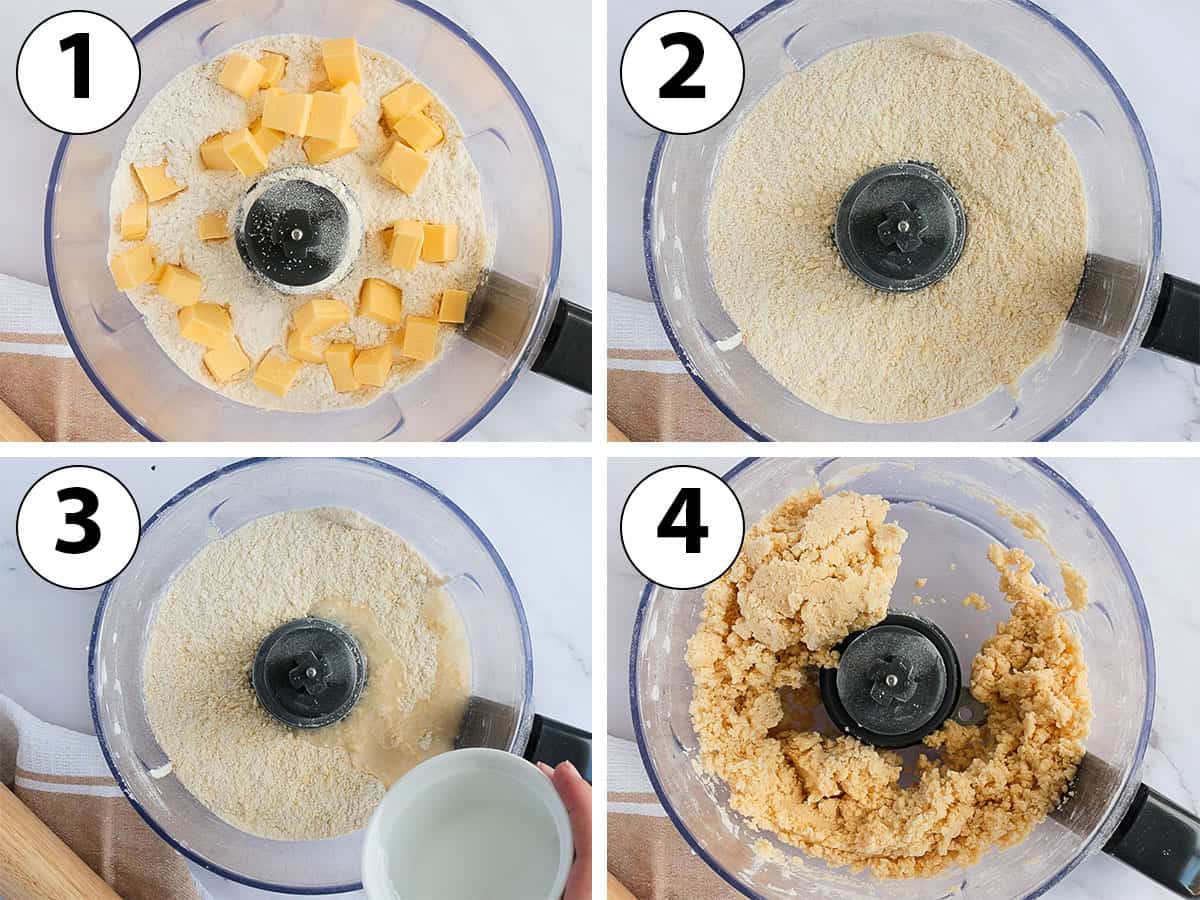
Making your own quiche pastry is easier than you think, especially with a food processor! It yields a superior flaky texture and flavor compared to store-bought options. If you prefer to make it by hand, you can find detailed instructions and tips in my dedicated Savoury Shortcrust Pastry recipe.
- Photo 1: Begin by placing your all-purpose flour and fine table salt into the bowl of your food processor. If you’re adding any extra spices like cumin or a pinch of paprika, now is the time to include them. Pulse the mixture a few times to ensure everything is well combined. Then, add the very cold, cubed unsalted butter. The coldness of the butter is paramount for a flaky crust.
- Photo 2: Process the ingredients for about 20-30 seconds. You want to achieve a texture where the butter is finely dispersed throughout the flour, resembling small crumbs, almost like coarse sand. There should still be visible pea-sized pieces of butter, which are key to creating those desirable flaky layers. Ensure the butter and flour are evenly distributed.
- Photo 3: With the food processor running, slowly drizzle in the ice-cold water. It’s crucial to add the water gradually to avoid over-hydrating the dough. You might need slightly less or more water than the recipe specifies, as flour absorption varies.
- Photo 4: Continue mixing just until a rough dough starts to form. The dough should look shaggy but hold together when pressed. Avoid over-mixing; overworking the dough develops gluten, leading to a tough crust.
A note on water quantity: The exact amount of water can fluctuate based on factors like the brand of flour you’re using and the humidity in your kitchen. It’s always best to add water slowly, pausing to check the consistency. To test if the dough is ready, press a small handful of the mixture in your palm. If it comes together smoothly without crumbling, it’s perfect. If it’s still too dry or crumbly, add a tiny bit more cold water, a teaspoon at a time, and pulse again until just combined.

- Photo 5: Gently transfer the shaggy dough onto a large sheet of baking paper. Bring the crumbs together to form a cohesive ball, being careful not to knead it excessively, as this can make it tough and difficult to roll. Flatten the ball slightly into a large disk.
- Photo 6: Place another sheet of baking or parchment paper over the dough. Using a rolling pin, roll the dough evenly into a large circle, approximately 4mm (1/6 inch) thick. Rolling between two sheets of paper prevents sticking and ensures a smooth surface. Transfer this rolled dough (still between the paper) onto a flat baking tray and refrigerate for at least 1 hour, or ideally, overnight. This chilling period is crucial for the pastry to relax and prevent shrinkage during baking.
- Photo 7: Once chilled, remove the dough from the fridge and carefully peel off one sheet of baking paper. Let it sit at room temperature for about 5 minutes to slightly soften, making it easier to handle without cracking. Then, carefully invert it into your quiche pan and peel off the second sheet of paper. I used a 25 cm (10-inch) wide quiche pan with 4 cm (1.5-inch) tall edges for this recipe, ensuring enough depth for the rich filling.
- Photo 8: Gently slide the pastry down the sides of the quiche pan, pressing it firmly into the bottom corners and against the fluted edges. It’s important that the pastry is completely flush with the pan and adheres well to prevent gaps. Use a sharp knife or kitchen scissors to carefully trim any excess dough around the edges, leaving a small overhang if desired.
- Place the lined quiche pan back into the refrigerator to chill for at least 1 hour, or for best results, overnight. This second chilling step is vital; the colder and more relaxed the dough, the less it will shrink or collapse in the oven, ensuring a beautifully formed crust.
- Preheat your oven to 160°C (325°F). While the oven preheats, transfer your chilled quiche crust to the freezer for 10-15 minutes. This shock of cold helps prevent the crust from slumping. Once ready, dock the bottom of the pastry all over with a fork (making small holes) to allow steam to escape. Line the crust with baking paper and fill it with baking weights, dried beans, or rice.
- Par-bake the crust for 15 minutes. Then, carefully remove the weights and baking paper and continue baking for another 10 to 15 minutes, or until the crust appears dry and lightly golden. This par-baking step is essential to prevent a soggy bottom. Once par-baked, set the crust aside to cool completely before adding the filling.
Preparing the Flavorful Smoked Salmon and Leek Filling

Once your pastry shell is beautifully par-baked and cooling, it’s time to assemble the star of the show: the rich and flavorful filling.
- Photo 9: Start by thoroughly washing and finely chopping your leek. Leeks can sometimes hide grit, so rinse them well under running water. Heat the olive oil in a large skillet or frying pan over medium heat. Add the chopped leeks and sauté for about 5-7 minutes, stirring occasionally, until they are soft, translucent, and slightly sweet. Set them aside to cool slightly.
- While the leeks cool, cut your smoked salmon into small, bite-sized pieces. This ensures an even distribution of flavor throughout the quiche. Set these aside.
- Photo 10: In a large mixing bowl, prepare the creamy custard. Whisk together the eggs and heavy cream until well combined and slightly frothy. This aeration contributes to a lighter, fluffier texture. Stir in the salt, black pepper, garlic powder, finely chopped fresh dill, and the grated Gruyère cheese. Mix gently until all the ingredients are fully incorporated.
- Photo 11: Arrange the cooked leeks and pieces of smoked salmon evenly over the bottom of your cooled, partially baked quiche crust. Alternate layers or scatter them for a beautiful distribution of ingredients in every slice. Optionally, reserve a few pieces of salmon to place decoratively on top of the quiche later.
- Photo 12: Carefully pour the egg custard mixture over the salmon and leek filling in the crust. Ensure the filling is submerged. If you reserved any salmon pieces or additional grated cheese, scatter them on top for a delightful finish.
- Bake the quiche in a preheated oven at 180°C (350°F) for 40 to 50 minutes. The exact baking time can vary depending on your oven and the depth of your quiche pan.
How to know your quiche is perfectly baked: Gently, and very carefully, jiggle the quiche pan (using oven mitts!). If the center of the quiche still has a significant wobble, it needs more time. A perfectly set custard will only have a slight, almost imperceptible jiggle in the very center. If you notice the crust browning too quickly or becoming too dark before the custard is set, loosely cover the edges (or the entire top) with aluminum foil to prevent burning.
- Once baked to perfection, remove the quiche from the oven and allow it to cool on a wire rack for at least 10 to 15 minutes before slicing and serving. This cooling time allows the custard to fully set, making for cleaner slices and preventing the filling from spilling out.
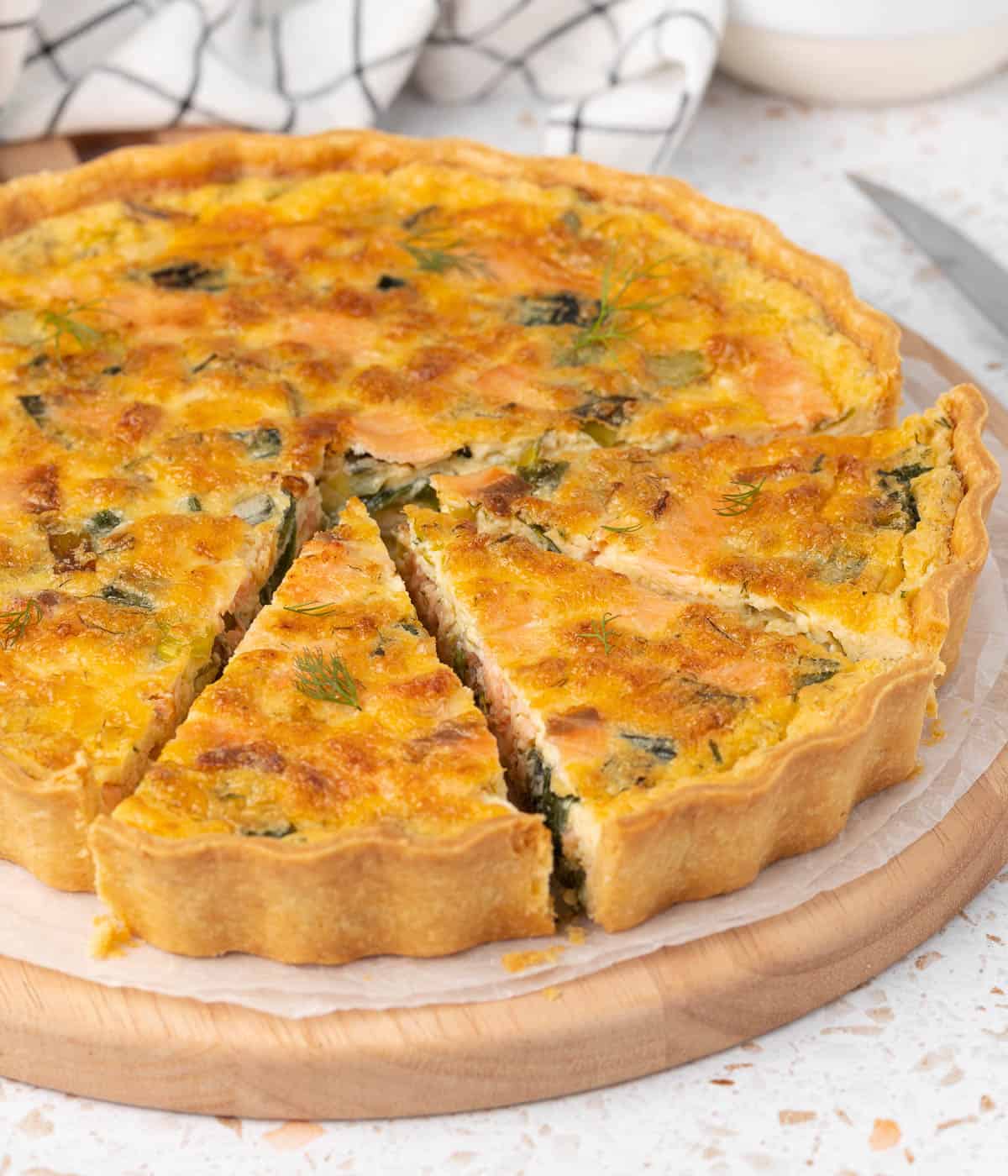
Frequently Asked Questions About Smoked Salmon Quiche
Absolutely, using a good quality store-bought pie crust or pastry is a convenient shortcut. However, be mindful that many store-bought options, both fresh and frozen, tend to be on the sweeter side. For a savory quiche, it’s best to choose a pastry that is explicitly labeled as plain or savory. A puff pastry could also work well if you’re looking for an even flakier texture, but you might need to adjust the par-baking times as puff pastry can bake differently and may experience more shrinkage than a shortcrust. Always remember to dock and par-bake the crust to prevent a soggy bottom, regardless of whether it’s homemade or store-bought.
While this recipe is designed for a crust, you can certainly try making it crustless! The rich custard filling will still be incredibly flavorful. If you opt for a crustless version, ensure you generously grease your baking dish to prevent the custard from sticking. Using a springform pan or a pie dish with a removable bottom could also make serving easier. The baking time might be slightly shorter for a crustless quiche, so keep an eye on it and check for the “slight jiggle” in the center to ensure it’s fully set.
This quiche is incredibly versatile and delicious on its own, but it truly shines when served with simple accompaniments. For an added touch of creaminess and tang, offer a dollop of crème fraîche or light sour cream on the side. A sprinkle of extra fresh dill just before serving enhances its aromatic appeal. To complete the meal, pair it with a crisp, light green salad dressed with a simple vinaigrette – the fresh greens provide a lovely counterpoint to the richness of the quiche, creating a perfectly balanced and satisfying meal for any time of day.
Yes, this quiche is fantastic for making ahead! You can bake it completely, let it cool, and store it in the refrigerator for up to 3 days. For best results, reheat the entire quiche loosely covered with foil in a preheated oven (around 160°C/325°F) for 15-20 minutes until warmed through. Individual slices can be reheated in the oven for 5-10 minutes. While you can microwave individual slices, be aware that the pastry might become less crisp and more soggy, so oven reheating is recommended for texture.
I recommend using a 25 cm (10-inch) wide quiche pan with 4 cm (1.5-inch) deep fluted edges. A metal pan with a removable bottom is ideal, as it makes removing the quiche incredibly easy and helps ensure a crisp crust. If you only have a ceramic or glass pie dish, it will work, but you might need to adjust baking times slightly and be extra careful when removing the slices.
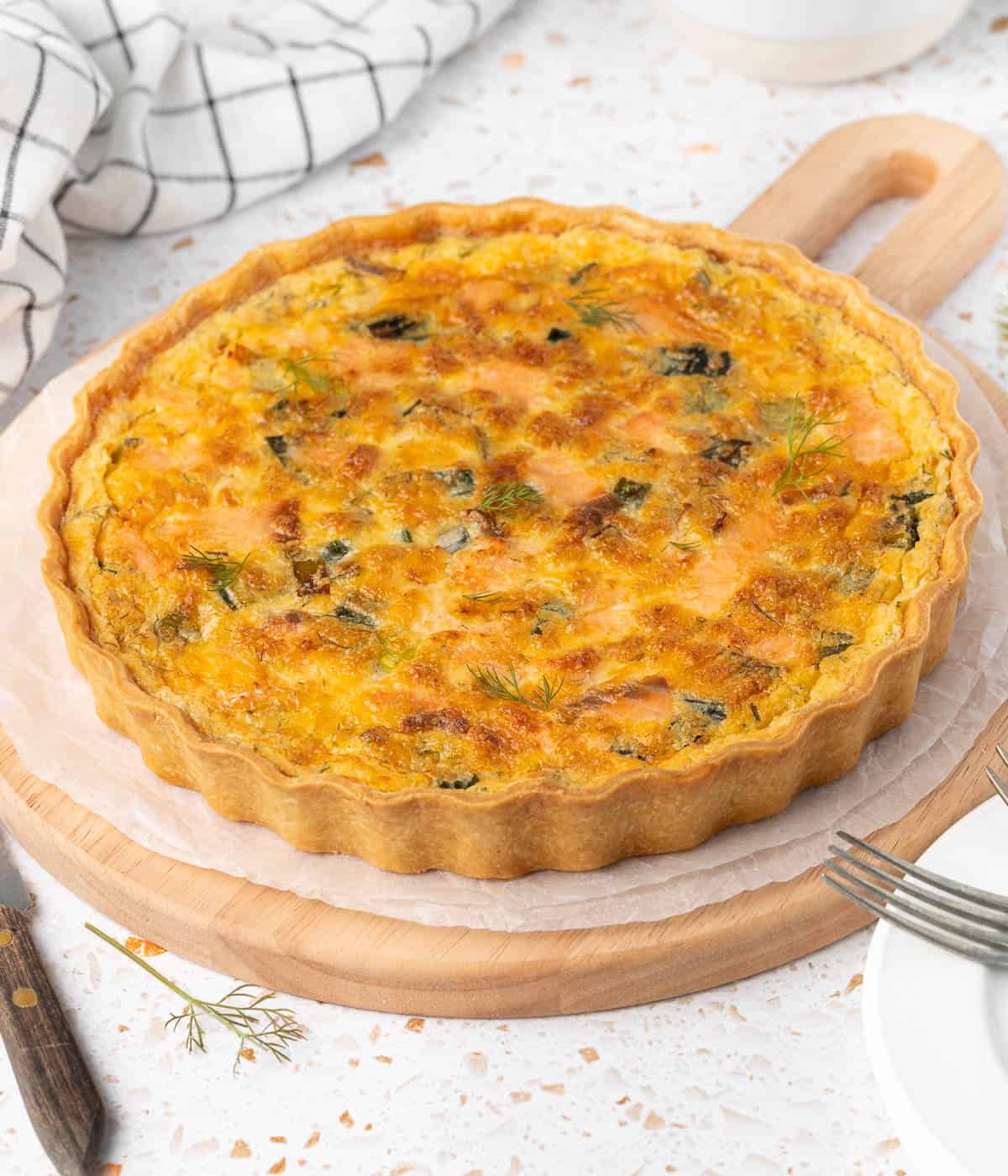
Pro Tips & Troubleshooting for Quiche Perfection
- Achieving the Perfect Pastry Consistency: When making your shortcrust pastry, the key is to avoid adding too much water. After blending the butter into the flour, add water incrementally. To check for the right consistency, gather a small handful of the crumbly dough and squeeze it. If it holds together easily and forms a smooth mass, it’s ready. If it’s still too dry and falls apart, add a tiny bit more ice-cold water (half a teaspoon at a time) and pulse briefly until just combined. Overworking the dough or adding too much water will result in a tough crust.
- The Importance of Chilling: Proper chilling of the pastry is absolutely essential for a successful quiche. Chilling the dough twice—once after mixing and again after lining the pan—allows the gluten to relax and the butter to firm up. This prevents the crust from shrinking excessively, slumping down the sides of the pan, or becoming tough during baking, ensuring a beautiful, flaky, and stable shell. For the absolute best results, try to chill the pastry in the pan overnight; this extended rest makes a noticeable difference.
- Knowing When Your Quiche is Fully Baked: To ensure your custard is perfectly set, gently shake the quiche pan (always with oven mitts!). A fully baked quiche will only have a very slight, delicate jiggle in the dead center, similar to firm gelatin. If it’s still very liquidy or wobbly, it needs more time. If the crust or the top of the quiche starts to brown too much before the center is set, loosely tent it with aluminum foil to protect it while the filling finishes cooking.
- Preventing a Soggy Bottom: The par-baking step (blind baking) for the crust is not optional! It creates a barrier between the wet custard and the pastry, preventing the bottom from becoming soggy. Make sure to dock the crust well with a fork and use pie weights or dried beans to keep it from puffing up.
- Don’t Overfill Your Quiche: While it’s tempting to load up on filling, ensure you don’t overfill the pastry shell. Leave a small margin (about half an inch) from the top rim of the crust to prevent the custard from spilling over during baking.
Storing & Freezing Your Smoked Salmon Quiche
One of the many advantages of quiche is how well it stores, making it an excellent option for meal prepping or entertaining.
The baked Smoked Salmon Quiche will remain delicious for up to 3 days when stored properly in the refrigerator. To keep it fresh and prevent it from absorbing other fridge odors, ensure it’s tightly covered with plastic wrap or aluminum foil. For the best flavor and texture, it’s generally recommended to consume it within 24-48 hours of baking.
Reheating Instructions: If you’re reheating a whole quiche, cover it loosely with aluminum foil and bake in a preheated oven at approximately 160°C (325°F) for 15 to 20 minutes, or until it’s warmed through to the center. For individual leftover slices, reheat them in the oven for about 5-10 minutes. While you can microwave slices for speed, be aware that this method tends to make the pastry softer and potentially soggy, so oven reheating is preferred for maintaining crust crispness.
Freezing Options: This quiche freezes beautifully, both baked and unbaked.
- To Freeze Unbaked: Prepare the pastry and line the pan. Assemble the filling (without pouring the custard) in the crust. You can freeze the prepared crust and filling separately, or assemble it fully (except for pouring the liquid custard). If freezing the whole assembled quiche unbaked, ensure it’s tightly wrapped in several layers of plastic wrap and then foil. When ready to bake, thaw in the refrigerator overnight, then add the custard and bake as directed, potentially adding a few extra minutes to the baking time.
- To Freeze Baked: Allow the baked quiche to cool down completely to room temperature. You can freeze the whole quiche or cut it into individual slices. Wrap it tightly in plastic wrap, then an additional layer of aluminum foil to prevent freezer burn. It can be stored in the freezer for up to 2-3 months. To reheat, thaw overnight in the refrigerator, then follow the oven reheating instructions above. You can also reheat from frozen (whole or slices) at a lower temperature (around 150°C/300°F) for a longer period (30-45 minutes for a whole quiche, 15-20 for slices), making sure it’s heated through.
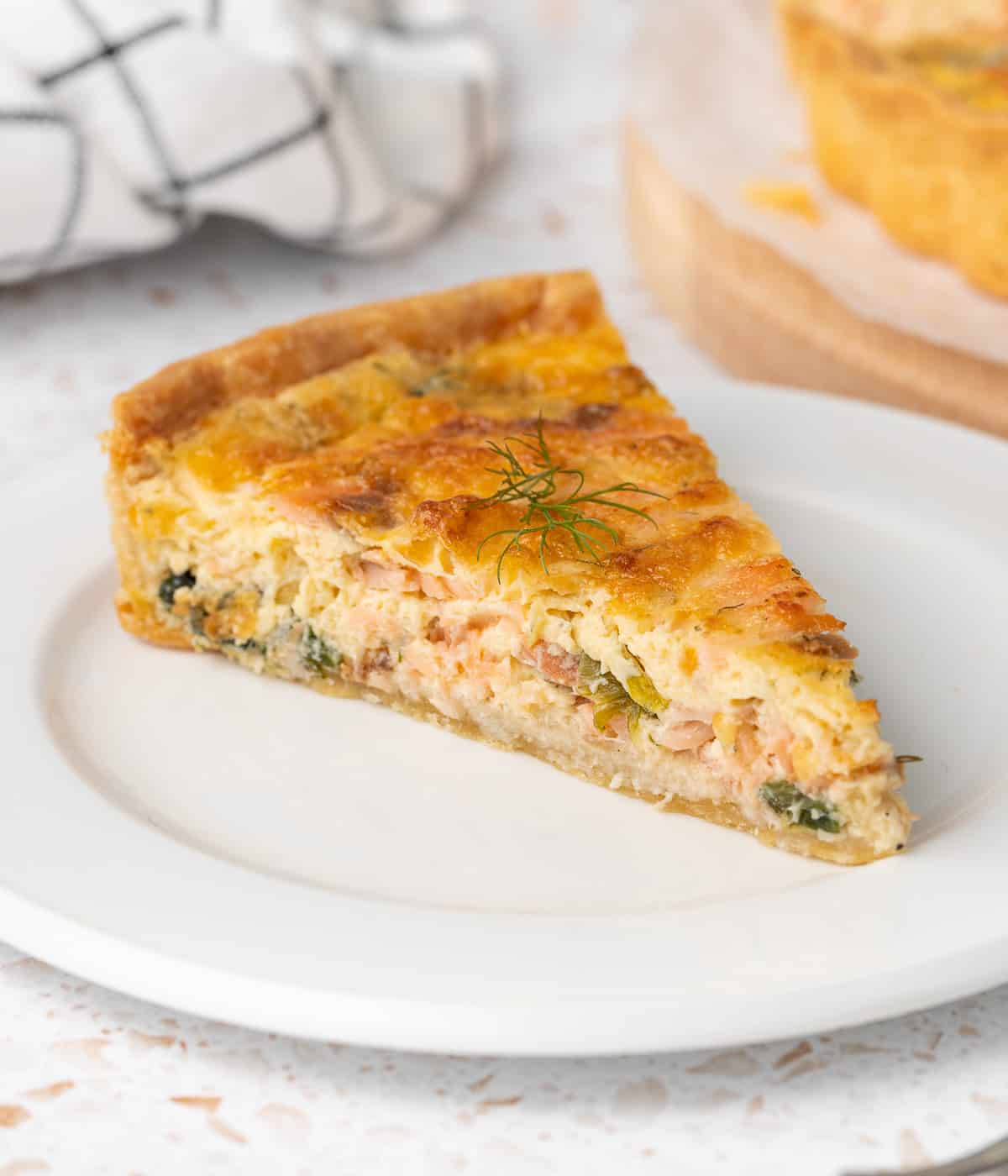
Explore More Delicious Quiche Recipes
If you’ve enjoyed this Smoked Salmon Quiche, you’ll love exploring other savory tart and quiche creations. Here are some more recipes to inspire your next baking adventure:
- Feta Asparagus Quiche: A vibrant and fresh springtime delight.
- Classic Cheese and Tomato Quiche: A timeless favorite for any meal.
- Spinach and Feta Quiche: A Mediterranean-inspired twist on a classic.
- Simple Leek Quiche with Gruyère: Highlighting the sweet tenderness of leeks.
- Hearty Broccoli and Cheddar Quiche: A comforting and wholesome family meal.
- Refreshing Zucchini Quiche with Feta and Mint: A light and aromatic summer option.
- Savory Mushroom and Spinach Quiche: Earthy and rich, perfect for mushroom lovers.
- 18 Delicious Vegetarian Quiche Recipes: A comprehensive collection for plant-based enjoyment.
I am so excited to share that my debut cookbook
“Bite-Sized French Pastries for the Beginner Baker”
is now available for purchase!
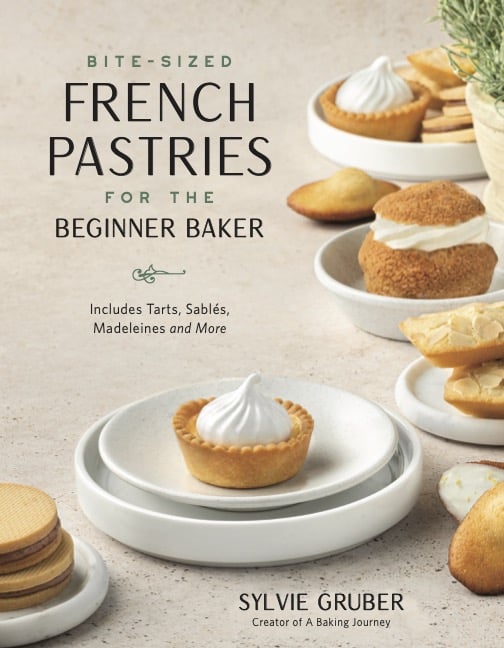
Recipe Card: Smoked Salmon Quiche with Leeks & Gruyère

Smoked Salmon Quiche
Print Recipe
Ingredients
Quiche Pastry
- 200 gr (1 1/3 cup) Plain / All-Purpose Flour
- 1/2 teaspoon Fine Table Salt
- 100 gr (6 1/2 tablespoons) Unsalted Butter, very cold, cut into small cubes
- 65 ml (1/4 cup + 1 teaspoon) Water, ice cold
Quiche Filling
- 1/2 large Leek, washed and finely chopped
- 1 tablespoon Olive Oil
- 200 gr (7 oz) Smoked Salmon, cut into small pieces
- 4 Eggs, medium to large size
- 300 ml (1 1/4 cup) Heavy / Thickened Cream
- 1 1/2 teaspoon Fine Table Salt
- 1/2 teaspoon Black Pepper, freshly ground
- 1 teaspoon Garlic Powder
- 2 tablespoon Fresh Dill, finely chopped
- 20 gr (1/2 cup) Gruyère Cheese, grated, or other hard cheese
Instructions
Quiche Pastry
- Place the Flour and Salt in the bowl of your food processor and pulse to combine (see note 1 for hand mixing). Add the very cold cubed Butter and pulse for about 30 seconds, or until the butter is turned into very small crumbs resembling coarse sand.
- While the food processor is running, slowly add the ice-cold Water. Continue to mix just until a rough dough starts to come together (see note 2 regarding water quantity).
- Transfer the dough onto a large sheet of baking paper and gently bring it together into a ball. Cover with a second sheet of baking paper, lightly flatten the dough with your hands, then roll into a large circle approximately 4 mm (1/6 inch) thick. Place on a flat tray and refrigerate for at least 1 hour, or preferably overnight.
- Remove the baking paper and carefully place the pastry inside a 25cm wide, 4 cm deep (10-inch x 1.5 inch) Quiche Pan (see note 3 for pan details). Gently slide the pastry down the sides of the pie dish, then press firmly into the bottom corners and against the sides of the pan. Trim any excess dough with a sharp knife.
- Place the lined quiche pan back in the fridge to rest and chill for at least 1 hour, or preferably overnight. This is crucial for preventing shrinkage.
- Preheat your oven to 160°C (325°F). While the oven preheats, put the quiche crust in the freezer for 10-15 minutes. Take out of the freezer, dock the bottom of the pastry (make small holes with a fork) and cover with baking paper, filling with baking weights (or dried beans/rice).
- Par-bake the crust for 15 minutes. Remove the weights and baking paper, then bake for an additional 10 to 15 minutes, or until lightly golden and dry. Set aside to cool down completely.
Quiche Filling
- Rinse and thinly chop half of a Leek. Place it in a large frying pan with the Olive Oil and cook on medium heat for about 5-7 minutes, or until soft and slightly translucent. Set aside to cool.
- Cut the Smoked Salmon into small, bite-sized pieces and set aside.
- In a large bowl, whisk together the Eggs and Heavy Cream. Add the Salt, Black Pepper, Garlic Powder, chopped Fresh Dill, and finely Grated Gruyère Cheese. Mix until well combined.
- Layer the cooked Leeks and pieces of Smoked Salmon evenly over the partially baked and cooled quiche crust (see note 4).
- Carefully pour the egg custard mixture over the filling. Optionally, top with any leftover salmon or leek and sprinkle with a little more grated cheese.
- Bake in the oven preheated to 180°C (350°F) for 40 to 50 minutes, or until the custard filling has set (see note 5 to check for doneness).
- Take the quiche out of the oven and let it cool on a wire rack for 10 to 15 minutes before slicing and serving.
- Optionally, serve with a dollop of Crème Fraîche and a garnish of fresh Dill.
Video
Would you like to save this recipe?
We’ll email this post to you, so you can come back to it later!
Notes
For more in-depth information on creating the perfect Quiche Pastry, including extensive tips and a full step-by-step process, please refer to my dedicated Savoury Shortcrust Pastry recipe.
I used a 25cm wide x 4cm deep (10 inch x 1.5 inch) Quiche Pan for this recipe, which yields a generous size suitable for serving 8-10 slices.
- Making the Pastry by Hand: If you prefer to make the pastry without a food processor, place the Flour and Salt in a large bowl. Add the very cold Butter, cut into small cubes. Use your fingertips or a pastry blender to rub the butter into the flour until the mixture resembles coarse breadcrumbs with some pea-sized butter pieces remaining. Gradually add the Water, working the dough with your fingers until it just comes together. Avoid overworking.
- Adjusting Water for Pastry: The exact quantity of water can vary based on your specific brand of flour and ambient humidity. To determine if the pastry is at the right consistency, press some of the dough firmly in your hand. If the crumbs stick together to form a smooth dough, it’s ready. If it remains dry and crumbly, add a very small amount (1/2 teaspoon) more ice-cold water at a time until the desired consistency is achieved.
- Handling Chilled Pastry: If your chilled pastry feels too stiff to roll or line the pan without cracking, let it sit at room temperature for about 5 to 10 minutes. This allows it to soften slightly, making it more pliable and easier to work with.
- Optional Toppings: For an appealing presentation, you can optionally reserve a few pieces of smoked salmon and some finely chopped leek or a sprinkle of additional grated cheese to strategically place on top of the quiche just before baking. This adds visual interest and highlights the key ingredients.
- Checking for Custard Doneness: To ensure the custard is fully set, gently (and with great care, using oven mitts) jiggle the quiche pan. A perfectly baked custard will show only a slight, almost imperceptible wobble in the very center. If it still visibly jiggles like liquid, it needs more baking time. If the crust or top starts to brown excessively, cover it loosely with aluminum foil to prevent burning while the custard finishes cooking.
Nutrition (per serving)
Made this recipe?
Let us know if you liked it by leaving a comment below, and tag us on Instagram @a.baking.journey with a photo of your creation!
We hope you’ve enjoyed this comprehensive guide to making the ultimate Smoked Salmon Quiche with Leeks and Gruyère. This recipe is a testament to how simple ingredients, when carefully combined, can create a truly memorable dish. Whether you’re a seasoned baker or just starting your culinary journey, this quiche is designed for success and is guaranteed to impress. Happy baking!
